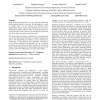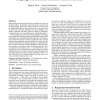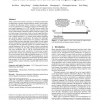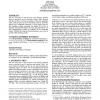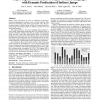ASPLOS
2008
ACM
14 years 6 months ago
2008
ACM
Many hardware optimizations rely on collecting information about program behavior at runtime. This information is stored in lookup tables. To be accurate and effective, these opti...
ASPLOS
2008
ACM
14 years 6 months ago
2008
ACM
Future multicore processors will be more susceptible to a variety of hardware failures. In particular, intermittent faults, caused in part by manufacturing, thermal, and voltage v...
ASPLOS
2008
ACM
14 years 6 months ago
2008
ACM
Today's processors provide a rich source of statistical information on application execution through hardware counters. In this paper, we explore the utilization of these sta...
ASPLOS
2008
ACM
14 years 6 months ago
2008
ACM
Power delivery, electricity consumption, and heat management are becoming key challenges in data center environments. Several past solutions have individually evaluated different ...
ASPLOS
2008
ACM
14 years 6 months ago
2008
ACM
Industry vendors hesitate to disseminate proprietary applications to academia and third party vendors. By consequence, the benchmarking process is typically driven by standardized...
ASPLOS
2008
ACM
14 years 6 months ago
2008
ACM
Concurrency control is one of the main sources of error and complexity in shared memory parallel programming. While there are several techniques to handle concurrency control such...
ASPLOS
2008
ACM
14 years 6 months ago
2008
ACM
Support for optimistic parallelism such as thread-level speculation (TLS) and transactional memory (TM) has been proposed to ease the task of parallelizing software to exploit the...
ASPLOS
2008
ACM
14 years 6 months ago
2008
ACM
ASPLOS
2008
ACM
14 years 6 months ago
2008
ACM
Indirect jump instructions are used to implement increasinglycommon programming constructs such as virtual function calls, switch-case statements, jump tables, and interface calls...
ASPLOS
2008
ACM
14 years 6 months ago
2008
ACM
